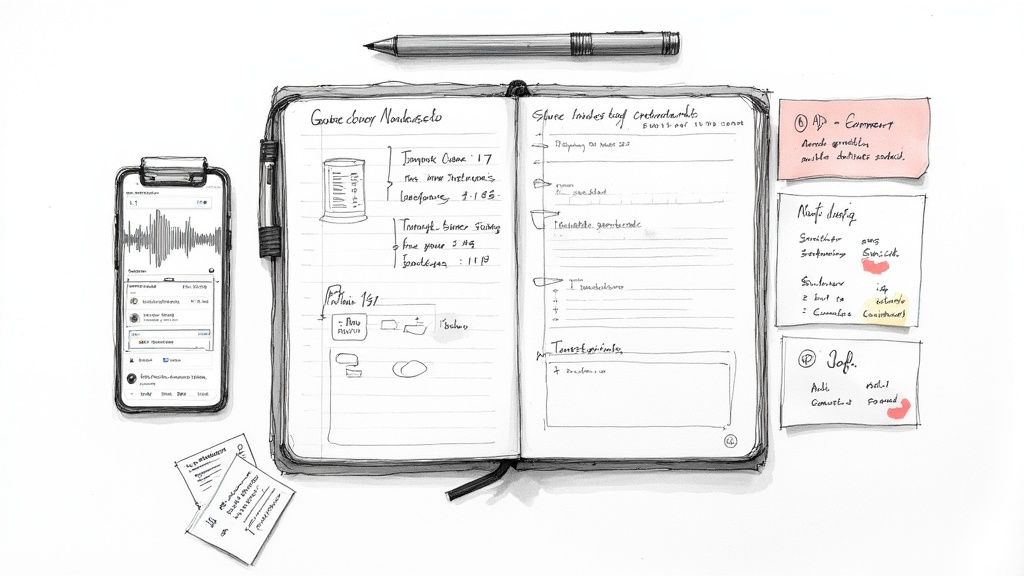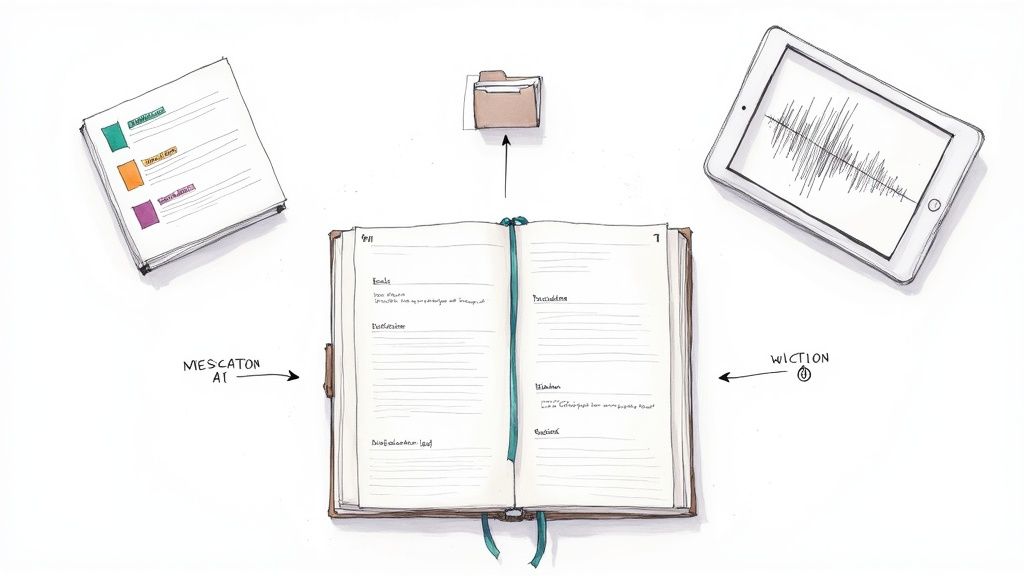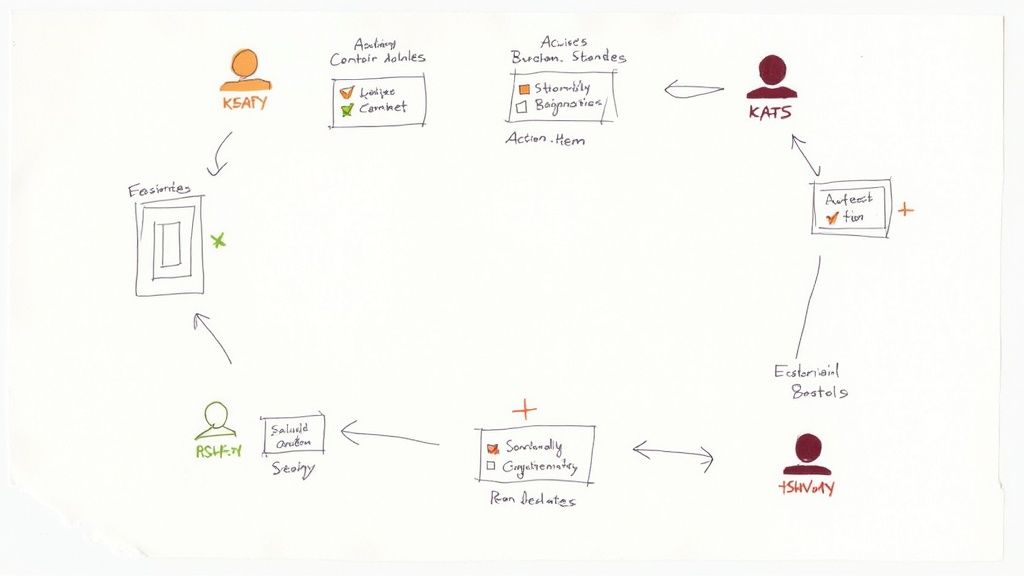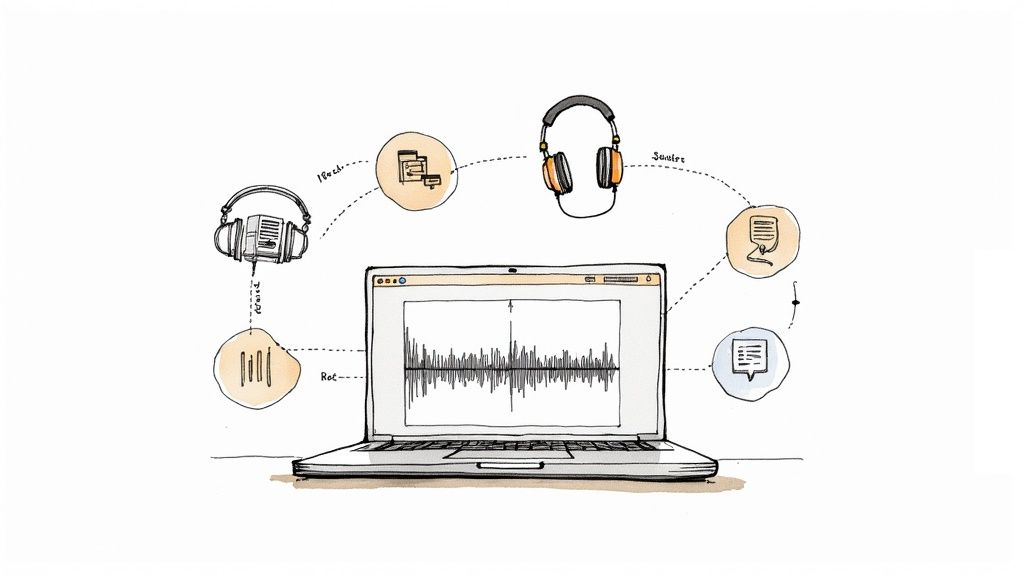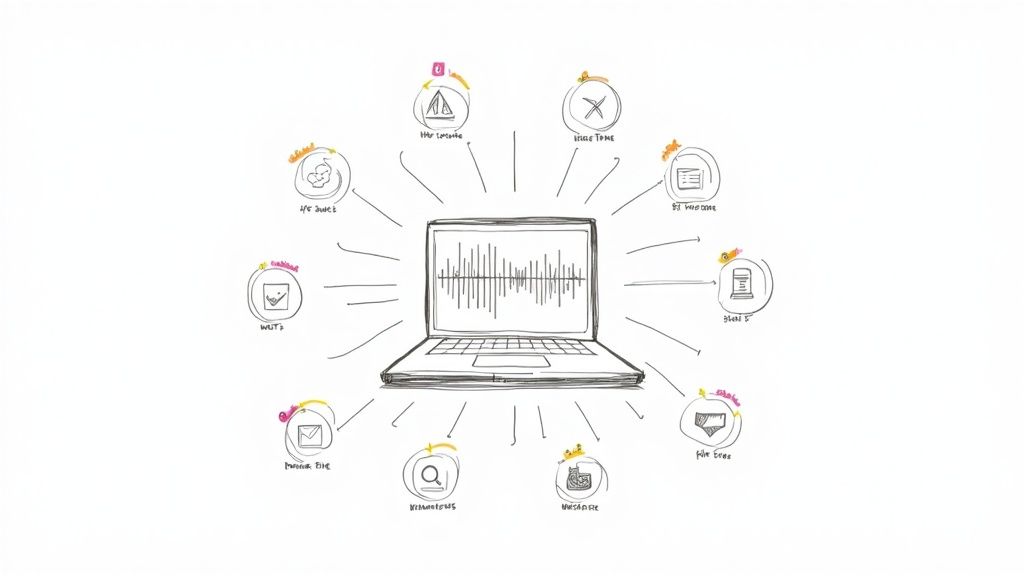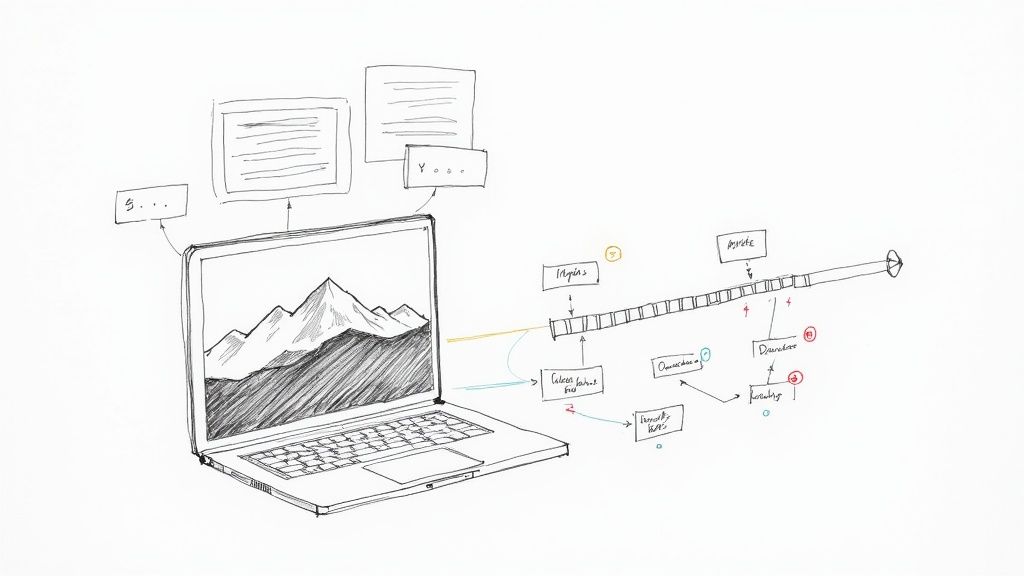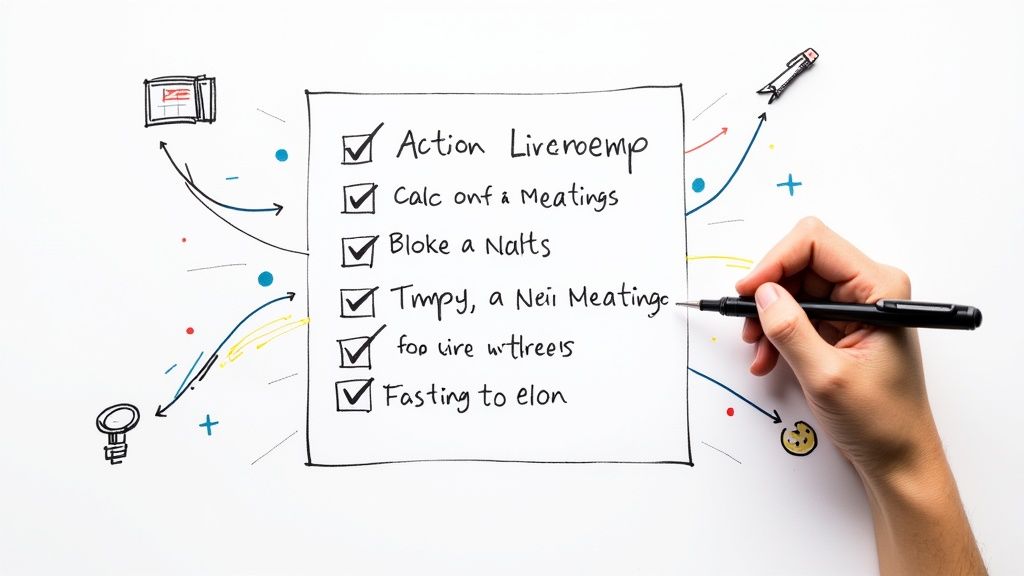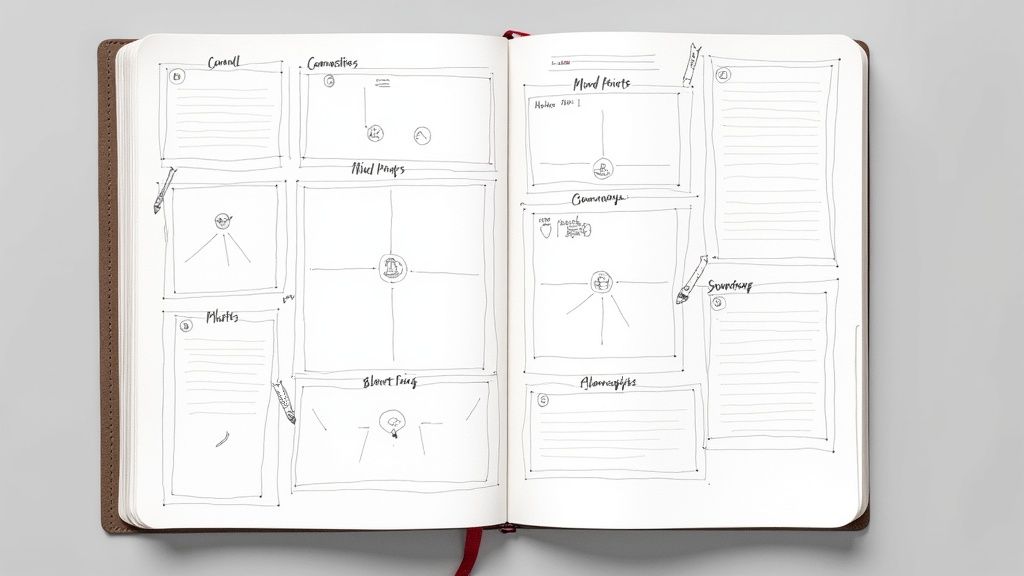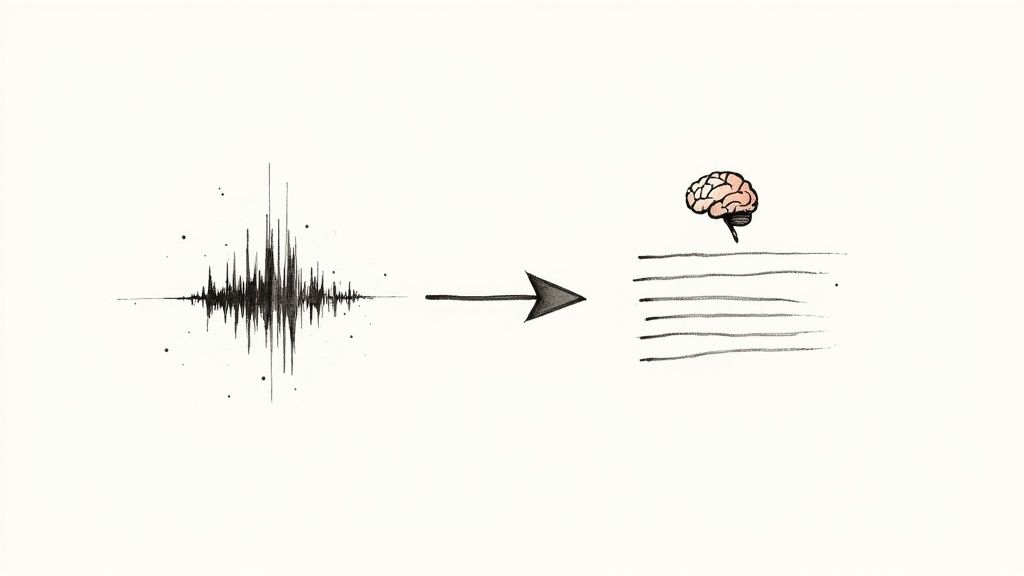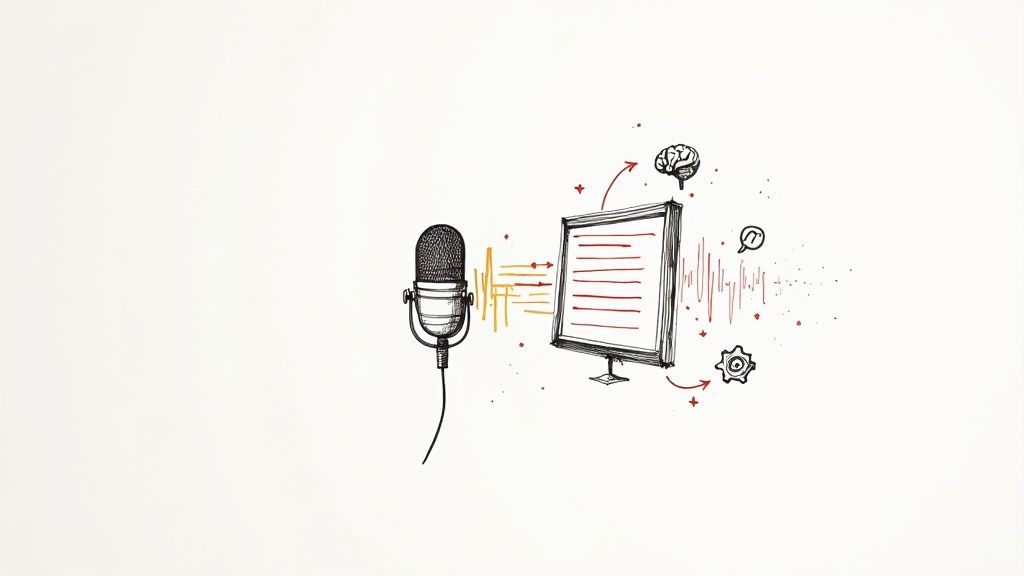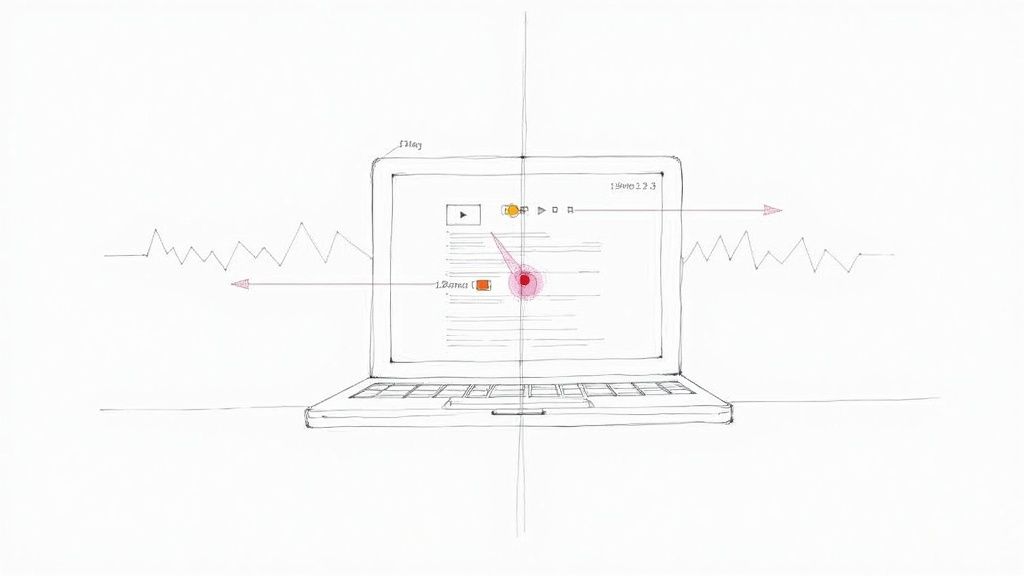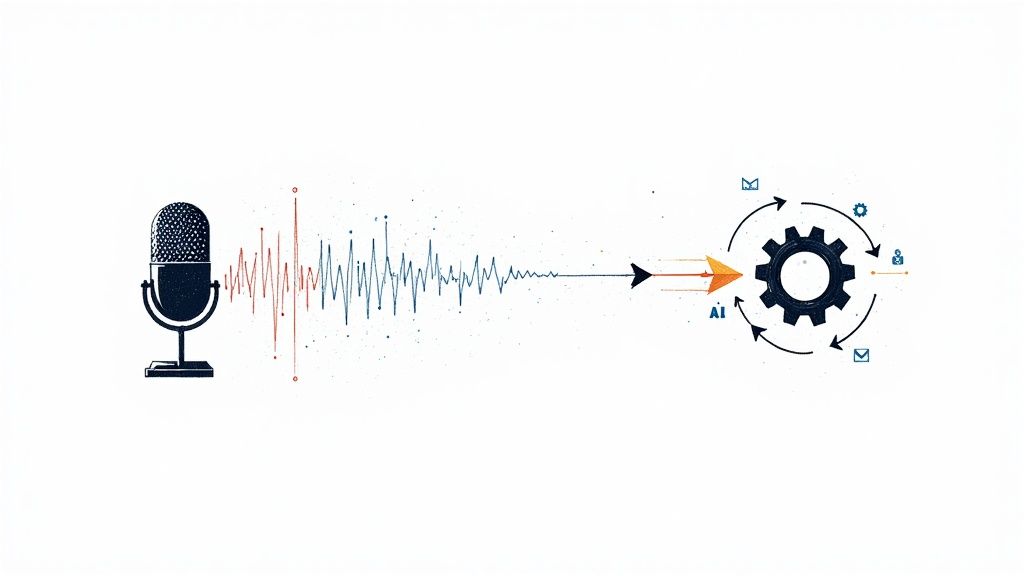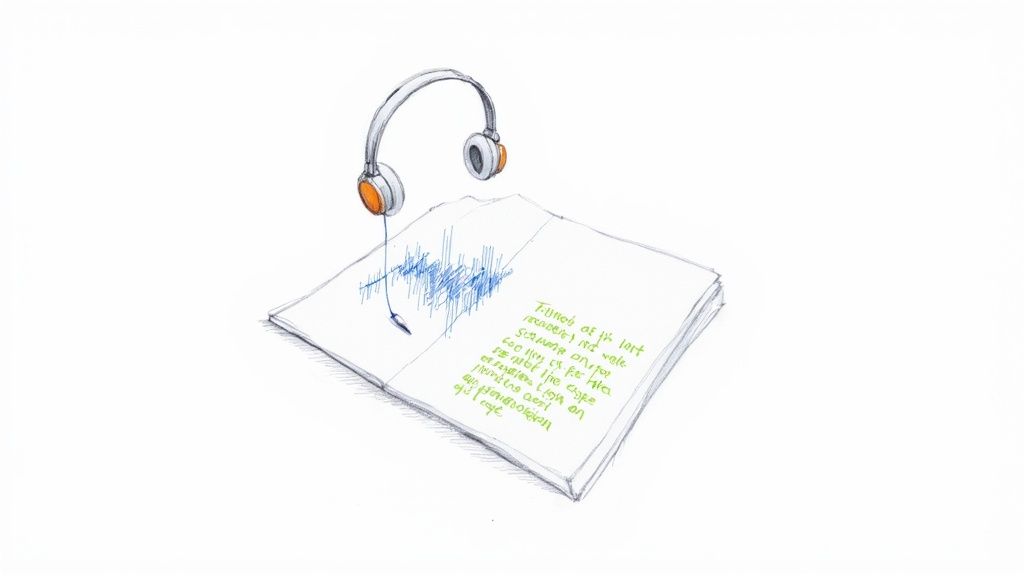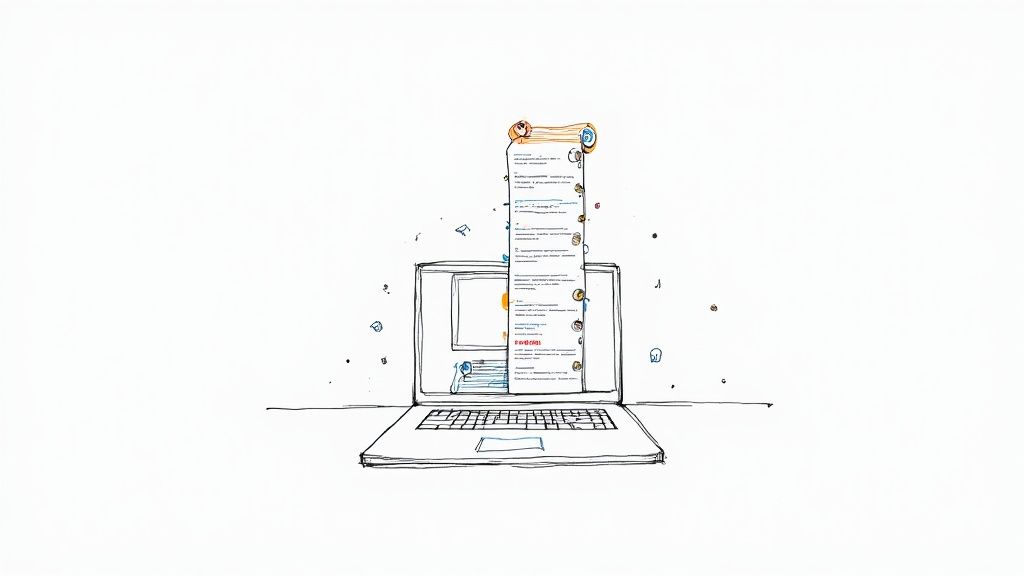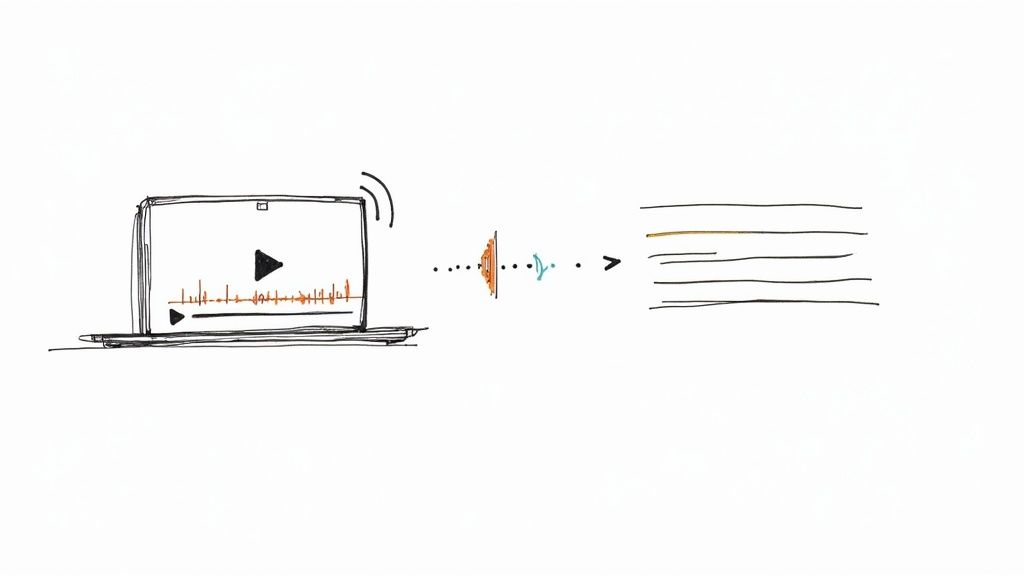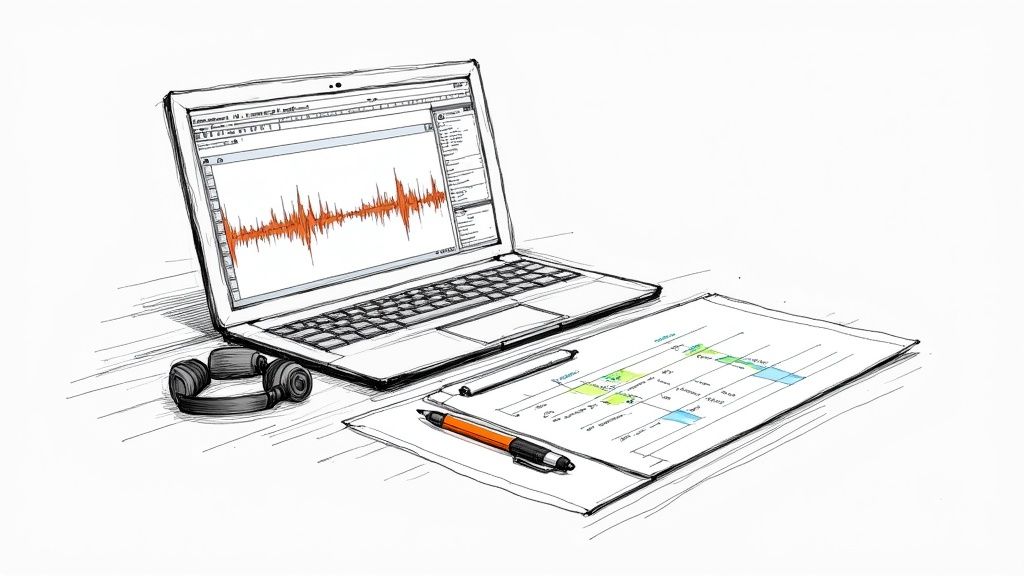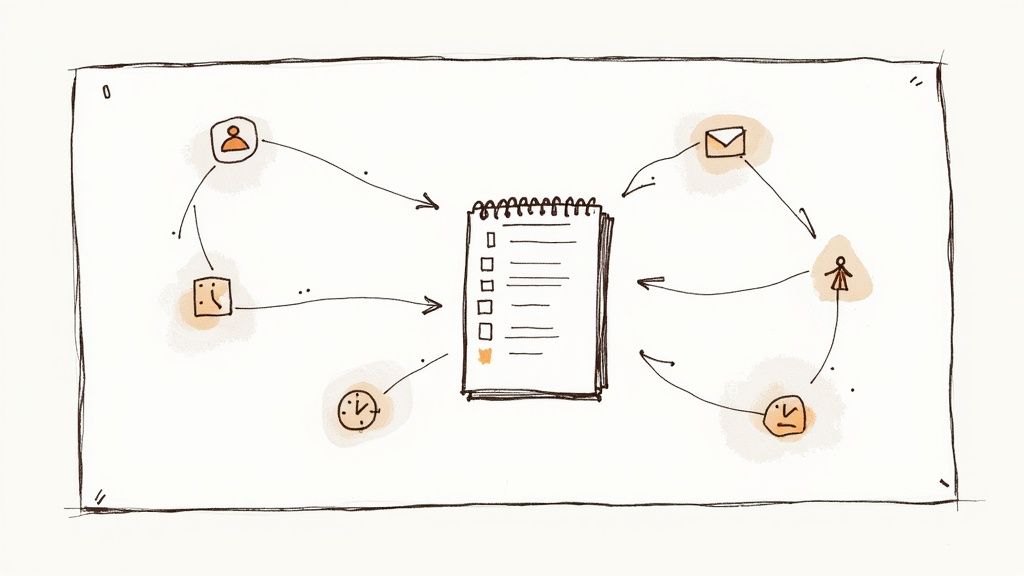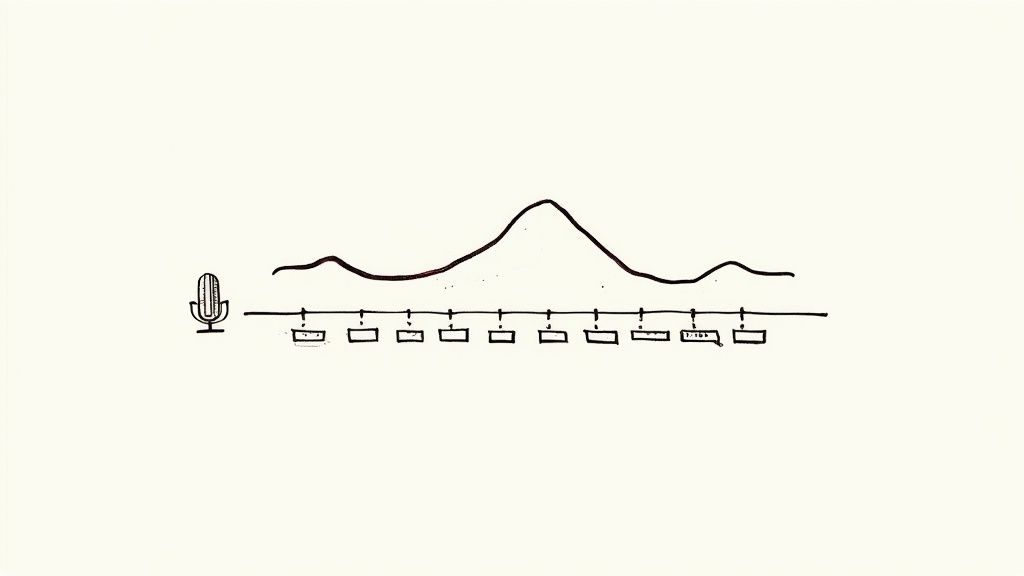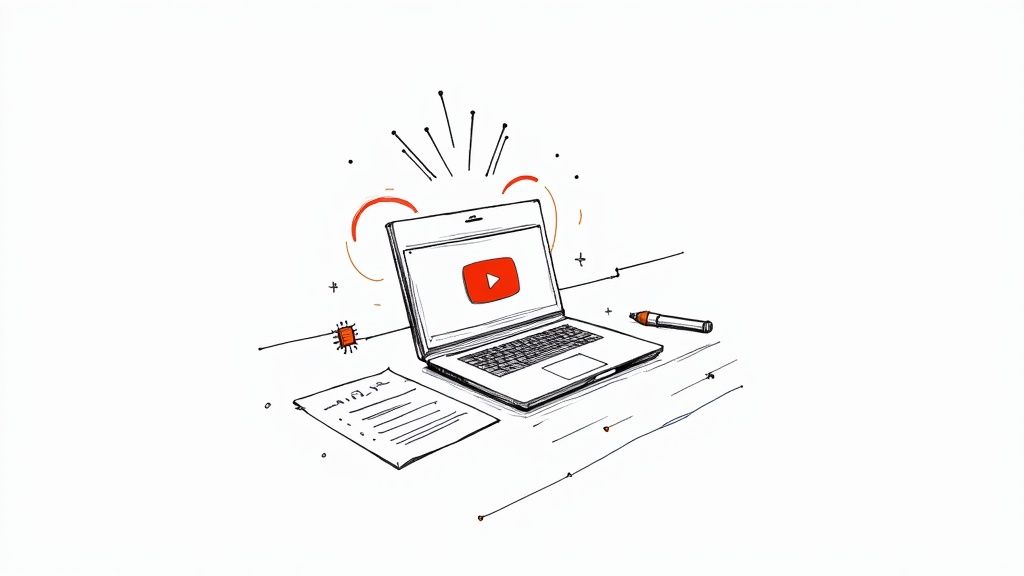
10 YouTube SEO Best Practices to Master in 2025
YouTube is more than a video-sharing site; it's the world's second-largest search engine, right behind its parent company, Google. For creators, this means visibility isn't a matter of luck or going viral by chance. It’s a direct result of a deliberate, data-driven strategy. Many talented content creators pour their energy into production quality but neglect the crucial signals that guide YouTube's algorithm to their target audience. From my experience growing channels, I've seen firsthand that this oversight is often the one thing holding a channel back from significant growth.
This guide provides a comprehensive blueprint to change that. We will move beyond generic advice and dive into 10 proven YouTube SEO best practices that top-performing channels use to dominate search results and suggested video feeds. These aren't just theories; they are actionable, experience-based tactics you can implement immediately to improve your channel's discoverability, boost watch time, and build a dedicated community.
From advanced keyword research and CTR optimization to leveraging transcripts and community engagement signals, each point is designed to give you a competitive edge. Think of this as your step-by-step manual for making the algorithm work for you, not against you. Whether you're a podcaster aiming for wider reach, a business building brand authority, or a new creator chasing your first 1,000 subscribers, mastering these core principles is essential for sustainable, long-term success on the platform. This article provides the practical steps needed to turn your content into a powerful discovery engine.
1. Master Keyword Research and Optimization
Effective YouTube SEO begins long before you hit "record." It starts with understanding what your audience is actively searching for. Mastering keyword research is about identifying viewer intent, not just chasing popular phrases. You need to uncover the specific questions, problems, and needs of your target audience to create content that provides direct answers and solutions.
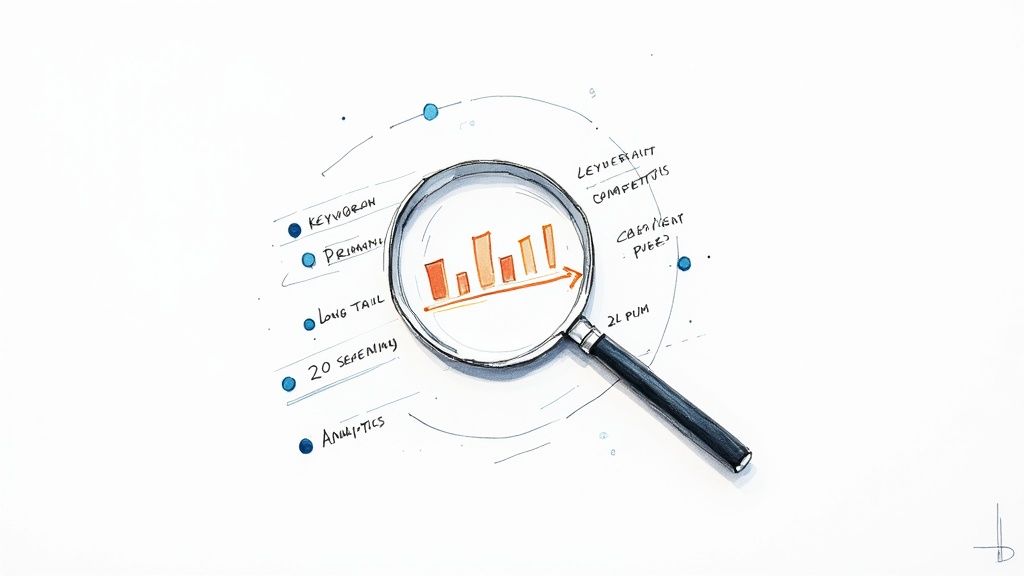
This foundational step ensures your video doesn’t get lost in the noise. By aligning your content's topic and language with the exact queries viewers are typing into the search bar, you drastically increase its chances of being discovered. This is a core principle of youtube seo best practices because it directly connects your video to a pre-existing demand.
Why It's the Bedrock of Your Strategy
Keyword research informs every subsequent optimization step, from your title and description to your tags and even the words you speak in your video. When done correctly, it helps YouTube’s algorithm understand your content's topic, relevance, and target audience, making it more likely to rank your video in search results and suggest it to relevant viewers.
How to Implement It
- Utilize YouTube's Search Bar: Start typing a potential video topic into the YouTube search bar. The autocomplete suggestions that appear are actual queries people are searching for. This is my go-to method for finding relevant long-tail keywords.
- Analyze Competitor Videos: Use tools like TubeBuddy or VidIQ to see the exact tags your competitors are using on their top-performing videos. This provides direct insight into what’s working for your niche.
- Target the Sweet Spot: For smaller channels, focus on keywords with a monthly search volume between 1,000 and 10,000. These terms often have less competition but still carry significant viewer interest, giving you a better chance to rank.
- Strategic Placement: Once you’ve identified your primary keyword, place it at the very beginning of your video title (ideally within the first 25 characters). Also, include it and 3-5 related variations naturally throughout your video description to reinforce its relevance.
2. Click-Through Rate (CTR) Optimization
Even with perfect keyword research, your video will fail if no one clicks on it. Click-through rate (CTR) is the percentage of people who see your video in search results or suggestions and actually click to watch. It's a powerful signal to YouTube’s algorithm that your content is compelling and relevant to a viewer's query. A high CTR tells YouTube that your video delivers on the promise made by its title and thumbnail.
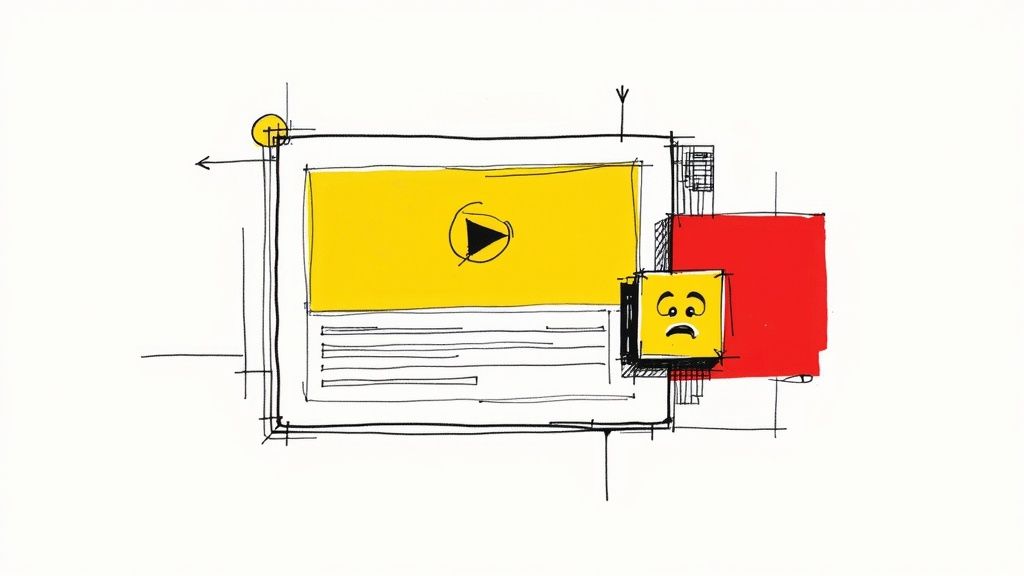
This metric is a crucial component of youtube seo best practices because it directly influences your video's initial momentum and visibility. YouTube wants to keep viewers on the platform, so it will prioritize promoting videos that effectively grab attention and entice a click. Optimizing your CTR is about mastering the art of the first impression.
Why It's a Critical Ranking Signal
Your title and thumbnail are your video's billboard. If they fail to attract clicks, YouTube assumes the content is not what viewers are looking for, regardless of its quality. A higher CTR leads to more initial views, which gives the algorithm more data on watch time and engagement, creating a positive feedback loop that can boost your video's ranking and suggested views.
How to Implement It
- Create High-Contrast Thumbnails: Use bright, complementary colors that stand out against YouTube's interface (white, dark grey, black). Creators like Ali Abdaal master this by using bold colors and clear facial expressions to convey emotion and draw the eye.
- Limit Thumbnail Text: Keep text on your thumbnail to 2-3 powerful words. The goal is to create curiosity, not provide a full summary. The text should be large, bold, and easily readable on a small mobile screen.
- A/B Test Your Thumbnails: Don't guess what works. Use tools like TubeBuddy to test different thumbnail variations. Even small changes, like altering a background color or facial expression, can significantly impact your CTR. Aim for a baseline of 3-5% and continuously test to improve.
- Write Compelling, Accurate Titles: Your title should work in harmony with your thumbnail. It must accurately reflect the video's content while creating intrigue or clearly stating the value a viewer will receive. Avoid clickbait that doesn't deliver, as this will hurt your watch time.
3. Engaging Video Titles and Description Optimization
Your video’s title and description are your primary sales pitch to both the YouTube algorithm and potential viewers. A great title sparks curiosity and promises value, while a well-crafted description provides the context and keywords the algorithm needs to understand and rank your content. It’s a delicate balance between human psychology and machine-readable data.
This synergy is crucial for discovery. An irresistible title gets the click, but a keyword-rich description helps your video appear in more search results and suggested video feeds. Mastering this combination is a non-negotiable part of implementing effective youtube seo best practices because it directly influences both click-through rate (CTR) and algorithmic relevance.
Why It's the Bedrock of Your Strategy
The title is the single most important piece of metadata for your video. It tells viewers what to expect and is heavily weighted by YouTube's search and discovery algorithm. The description complements this by offering a deeper dive, reinforcing primary keywords, introducing secondary keywords, and providing valuable resources that can increase viewer satisfaction and session time.
How to Implement It
- Front-Load Your Keyword: Place your main target keyword within the first 60 characters of your title. This ensures it's visible on all devices and immediately signals relevance to both search engines and users scanning results.
- Balance SEO with Intrigue: Create titles that are both searchable and compelling. For example, instead of "My Review of the New Camera," try "New Camera Review: Is It Worth The Hype? (Honest Thoughts)." This targets the keyword while adding a human element of curiosity.
- Write a Mini-Blog Post: Use the first 2-3 lines of your description to write a compelling, keyword-rich summary of the video's value. This is what viewers see before clicking "Show more," so it needs to be impactful and include a strong call-to-action (CTA).
- Structure for Success: Use timestamps to create video chapters for longer content, which improves user experience and can result in key moments being featured in Google Search. Include links to related playlists, social media, and affiliate products. Also, add a section with 3-5 related keywords to further inform the algorithm.
4. Audience Retention and Watch Time Maximization
While keywords get viewers to click, keeping them watching is what truly matters to YouTube's algorithm. Maximizing audience retention and watch time signals to YouTube that your video delivers on its promise and provides significant value. This is arguably the most powerful ranking factor, as YouTube’s primary goal is to keep users on the platform for as long as possible.
A video that holds a viewer's attention throughout its duration is more likely to be promoted in search results, suggested videos, and on the homepage. Mastering this aspect is one of the most critical youtube seo best practices because it directly influences your channel's visibility and growth more than almost any other metric.
Why It's the Ultimate Ranking Signal
High audience retention tells YouTube's algorithm that your content is engaging and satisfying. The longer a viewer watches, the more valuable the algorithm perceives your video to be. This leads to a positive feedback loop: better retention leads to more promotion by YouTube, which leads to more views and even more data validating your video's quality. Channels like MrBeast and Think Media have built empires by mastering the art of holding viewer attention.
How to Implement It
- Hook Viewers Immediately: The first 5-15 seconds are crucial. Start with a compelling question, a surprising statement, or a quick preview of the video's most exciting moments to prevent viewers from dropping off.
- Use Pattern Interrupts: Maintain a dynamic pace by using jump cuts, changing camera angles, adding B-roll, and incorporating text overlays or sound effects. These small changes break the monotony and reset the viewer's attention span.
- Structure for Retention: Build your video's narrative with strategic "retention hooks" every 2-3 minutes. These are mini-teasers or questions that create curiosity and encourage viewers to keep watching to find the answer.
- Analyze Your Analytics: Dive into YouTube Analytics to see your audience retention graphs. Identify where viewers are consistently dropping off and analyze what might be causing it. Use this data to refine the structure of your future content. For a deeper analysis of long-form videos, you can discover more about what makes them engaging with a YouTube video summarizer.
5. Strategic Tags and Metadata Optimization
While some debate their importance, video tags remain a crucial piece of metadata that helps YouTube's algorithm understand your content's context and nuances. Think of tags as signposts that clarify your video's topic, category, and potential relationship to other videos. They provide the algorithm with extra data points to confirm what your video is about, which can influence how it's categorized and recommended.
This process is a fundamental part of a complete youtube seo best practices checklist. Properly optimized tags act as a safety net, ensuring that even if your title and description don't cover every angle, YouTube still has enough information to correctly classify and surface your content to the right audience.
Why It’s a Key Contextual Signal
Tags are your opportunity to provide comprehensive context that may not fit naturally into your title or description. You can include synonyms, common misspellings, long-tail variations of your main keyword, and broader topic categories. This helps YouTube connect your video with a wider range of relevant search queries and improves its chances of appearing in the "Up Next" sidebar of similar videos.
How to Implement It
- Prioritize Your First Tag: Make your very first tag an exact match of your primary keyword. This gives YouTube a strong, immediate signal about the video's main focus.
- Mix Broad and Specific Tags: Use a combination of broad category tags (e.g., "content marketing") and specific, long-tail tags (e.g., "how to write a blog post for beginners"). This covers both general interest and high-intent searches.
- Analyze Competitor Tags: Leverage tools like VidIQ or TubeBuddy to analyze the tags on top-ranking videos in your niche. Identify common tags they use and incorporate relevant ones into your own strategy, but avoid simply copying them all.
- Keep It Focused: Aim for 5-10 highly relevant tags rather than stuffing the tag section with dozens of semi-related terms. Quality and relevance are more important than quantity. Misleading tags can harm your video's performance.
6. Playlist Strategy and Video Organization
A well-organized channel is a high-performing channel. Playlists are a powerful, yet often underutilized, tool that transforms individual videos into a cohesive viewing experience. Instead of a viewer watching one video and leaving, playlists guide them to the next relevant piece of content, dramatically increasing session watch time, a key metric YouTube’s algorithm favors.
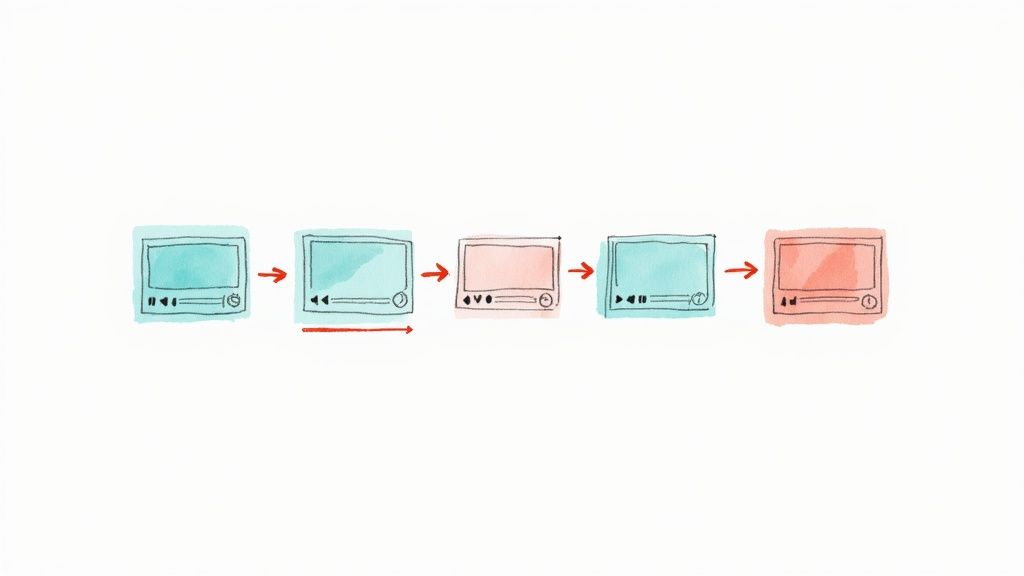
This strategic grouping isn't just for user convenience; it’s a direct signal to YouTube about the relationships between your videos. This is a crucial element of youtube seo best practices because it helps the algorithm understand your channel's authority on specific topics, making it more likely to suggest your content as a binge-worthy series.
Why It's a Watch Time Multiplier
Playlists serve as curated content paths that keep viewers on your channel longer. When a user finishes one video in a playlist, the next one automatically begins, which can significantly boost your total watch time and average view duration. Furthermore, optimized playlist titles and descriptions are indexed by YouTube search, creating additional assets that can rank and bring in new viewers.
How to Implement It
- Group by Core Topics or Series: Create playlists around the main content pillars of your channel. For example, a productivity channel might have playlists for "Time Management Techniques," "Habit Formation," and "Digital Organization Tools."
- Optimize Playlist Metadata: Treat your playlist title and description like you would for a standalone video. Use a primary keyword in the title (e.g., "Beginner's Guide to Digital Painting") and write a keyword-rich description explaining what the series covers.
- Establish a Logical Flow: Arrange the videos within the playlist in a logical sequence. If it's a tutorial series, order them from easiest to most advanced. This structured approach encourages viewers to complete the entire series.
- Promote Your Playlists: Don't just create playlists and hope people find them. Actively promote them using cards and end screens in your videos, and link to relevant playlists in your video descriptions.
7. Closed Captions (CC) and Transcript Optimization
Optimizing your video goes beyond what viewers see; it also includes what they can read. Closed captions (CC) and transcripts are powerful yet often overlooked tools that make your content accessible while providing a treasure trove of text for YouTube's algorithm to index. The platform's crawlers can read this text, giving them a deeper understanding of your video's context and relevance.
This process transforms your spoken words into a searchable asset. By providing accurate, keyword-rich captions, you directly tell the algorithm what your video is about, reinforcing the signals from your title and description. This is a critical component of modern youtube seo best practices because it improves both machine readability and human accessibility, leading to better rankings and a wider audience.
Why It's a Key Ranking Signal
YouTube’s primary goal is to keep viewers on the platform. Accessible content with accurate captions caters to a broader audience, including those who are deaf or hard-of-hearing, non-native speakers, or people watching in sound-sensitive environments. This increases potential watch time and engagement, which are strong positive signals for the algorithm. An accurate transcript acts as a full-text index of your video, enabling it to rank for a wider array of long-tail keywords spoken within the content.
How to Implement It
- Edit Auto-Generated Captions: YouTube's auto-captions are a good start, but they are notoriously inaccurate with proper nouns, technical jargon, and accents. Always manually review and edit them for punctuation, spelling, and grammar to ensure clarity and professionalism.
- Strategically Place Keywords: While editing your captions, naturally incorporate your primary and secondary keywords where they were spoken. Do not stuff them in; ensure the text accurately reflects the audio while reinforcing your main topic.
- Upload a Transcript File: To further enhance accessibility and SEO, learning how to get a transcript from a YouTube video can be invaluable for accurate captions and content repurposing. Upload this as a separate .srt file to give YouTube a clean, time-coded version of your script.
- Enable Multiple Languages: If relevant to your audience, use YouTube's community contribution tools or a professional service to translate your captions. This unlocks your content for a global audience, dramatically increasing its potential reach and discovery. You can learn more about leveraging YouTube transcripts to expand your reach.
8. Backlinks and External Cross-Promotion Strategy
While YouTube’s algorithm heavily favors internal metrics like watch time and engagement, your video’s influence doesn't have to stop at the platform's borders. Building a network of external links and promoting your content across different channels sends powerful authority signals to both YouTube and Google, driving valuable referral traffic and boosting your video's credibility.
This strategy expands your video's reach beyond YouTube's ecosystem. When high-quality, relevant websites link to your content, it validates its authority and can help it rank in traditional Google search results, creating a new and significant discovery path for viewers. This is a crucial element of advanced youtube seo best practices because it treats your video as a valuable asset for the entire web, not just a single platform.
Why It's a Powerful Growth Lever
Backlinks and external promotion act as a vote of confidence for your content. Each link from a reputable source tells search engines that your video is a trustworthy and valuable resource, which can positively influence its ranking. Furthermore, it diversifies your traffic sources, making your channel less dependent on the whims of the YouTube algorithm alone and building a more resilient audience.
How to Implement It
- Embed Videos in Blog Posts: If you have a blog, embed your relevant YouTube videos directly into your articles. This not only provides a backlink but also increases watch time as your blog readers engage with the video.
- Strategic Social Sharing: Don't just post a link to your new video. Create native content for each platform (e.g., a short clip for Instagram Reels, a poll on Twitter, a detailed post on LinkedIn) that directs traffic to the full video on YouTube.
- Leverage Email Newsletters: Your email list is a highly engaged audience. Send out a dedicated email announcement for new videos, encouraging subscribers to watch, like, and comment, which provides an initial velocity boost.
- Guest Appearances and Collaborations: When you appear on a podcast, write a guest post, or collaborate with another creator, ensure your YouTube channel or a specific video is linked in the show notes or author bio. This taps into established audiences and builds authoritative links.
9. Cultivate Community Engagement and Comment Strategy
YouTube SEO isn't just about what you upload; it's also about what happens after you hit "publish." Cultivating a vibrant community through comments and engagement sends powerful positive signals to the algorithm. This strategy involves actively fostering discussions and interactions that demonstrate your video is valuable, relevant, and resonating deeply with its audience.
This direct interaction transforms passive viewers into an active community. By strategically managing your comments and using tools like the Community tab, you signal to YouTube that your content inspires loyalty and conversation. This is one of the most powerful youtube seo best practices because it builds social proof and tells the algorithm that your content is worth promoting to a wider audience.
Why It's a Powerful Ranking Signal
High engagement, particularly within the first 24-48 hours, is a critical ranking factor. When YouTube sees viewers commenting, replying, and liking, it interprets this activity as a sign of high-quality, engaging content. This increases the likelihood that your video will be recommended in "Up Next" sidebars and featured on viewers' homepages, driving significant organic growth.
How to Implement It
- Front-load Your Engagement: Make it a priority to respond to as many comments as possible, especially within the first few hours of a video going live. Ali Abdaal famously grew his channel by replying to the vast majority of comments early on, making viewers feel seen and encouraging more interaction.
- Pin High-Value Comments: Find a comment that adds valuable insight, asks a great follow-up question, or is particularly funny. Pin it to the top to encourage further discussion and showcase the quality of your community.
- Prompt Discussion Actively: End your videos with a specific, open-ended question related to the content. Also, pose questions in your description and pinned comment to give viewers multiple opportunities to engage.
- Leverage the Community Tab: Use the Community tab 2-3 times per week to post polls, ask questions, or share behind-the-scenes content. This keeps your audience engaged between uploads and strengthens your channel's relationship with subscribers.
10. Content Calendar and Consistent Publishing Schedule
YouTube’s algorithm rewards reliability. Maintaining a predictable, consistent upload schedule signals to the platform that your channel is an active and dependable source of content. This regularity helps build algorithmic trust, encouraging YouTube to surface your videos more often to potential viewers.
A consistent publishing cadence does more than just please the algorithm; it trains your audience. When viewers know when to expect new content, they are more likely to return, subscribe, and engage. This practice is a cornerstone of youtube seo best practices because it fosters the audience loyalty and predictable viewership patterns that the platform is designed to promote.
Why It's a Key Algorithmic Signal
Consistency is interpreted by YouTube as a sign of a serious, high-quality channel. An active channel that publishes on a predictable schedule is seen as more valuable to the platform's ecosystem than one with sporadic, unpredictable uploads. This algorithmic favor leads to better visibility in search, browse features, and suggested video feeds. It directly impacts your channel's momentum and growth trajectory.
How to Implement It
- Establish a Realistic Cadence: Start with a schedule you can genuinely maintain, such as one video per week. For channels like Linus Tech Tips, daily uploads work, but for others like CGP Grey, quality over quantity is key. Consistency is more important than high frequency.
- Batch Your Content Production: Film and edit multiple videos in a single session or week. Creating a buffer of 4-8 weeks of content before launching or announcing your schedule reduces production pressure and ensures you never miss an upload.
- Utilize YouTube's Scheduling Tool: Upload your finished videos in advance and schedule them to go live at optimal times for your audience. Analyze your YouTube Studio analytics to identify which days and times your viewers are most active.
- Communicate Your Schedule: Announce your publishing schedule in your channel banner, video descriptions, and end screens. Setting this expectation helps your audience build a viewing habit around your content, just as creators like Ali Abdaal have done to build loyal followings.
YouTube SEO: 10 Best Practices Comparison
Turning Best Practices into Consistent Growth
Navigating the landscape of YouTube SEO can feel like trying to solve a complex, ever-changing puzzle. We've explored a comprehensive suite of YouTube SEO best practices, from foundational keyword research and metadata optimization to advanced strategies involving community engagement and content scheduling. The journey from a novice creator to a seasoned strategist isn't paved with a single secret or a one-time trick; it's built through the consistent, deliberate application of these interconnected principles. Think of each practice not as a separate task to check off a list, but as a gear in a larger machine. Your machine is your channel's growth engine.
When your keyword research informs a compelling video title, you've connected two critical gears. When that title is paired with a high-impact thumbnail to boost your CTR, another gear clicks into place. A strong video hook that captivates viewers from the start then turns the powerful gear of audience retention, signaling to YouTube that your content is valuable. This positive signal is amplified further when you foster a vibrant community in your comments and strategically organize videos into playlists, keeping viewers on your channel longer. Each element builds upon the last, creating a powerful flywheel effect that generates momentum and sustainable growth.
From Information to Implementation: Your Actionable Next Steps
The sheer volume of advice can be overwhelming, but the key to progress is focused action, not attempting to perfect everything at once. Your immediate goal should be to identify the one or two areas that offer the greatest potential for improvement for your specific channel. Your YouTube Analytics dashboard is your treasure map here; it will tell you exactly where to start digging.
Here is a simple framework to guide your next steps:
- If your videos have low impressions: Your primary focus should be on discovery. Dive back into keyword research (Item #1) and optimize your titles, descriptions, and tags (Items #3 & #5). This is about ensuring the YouTube algorithm understands what your content is about and who to show it to.
- If you have high impressions but a low Click-Through Rate (CTR): Your problem is packaging. Your content is reaching the right audience, but it isn't compelling them to click. Dedicate your energy to mastering thumbnail design and crafting irresistible, curiosity-driven titles (Item #2).
- If your CTR is strong but Audience Retention is poor: This points to a content issue. Viewers are interested, but the video itself isn't delivering on the promise of the title and thumbnail. Analyze your watch time graphs (Item #4) to pinpoint where viewers are dropping off and refine your video structure, intros, and overall pacing.
- If all the above metrics are solid but growth is stagnant: Your opportunity lies in amplification and authority. Focus on building engagement signals through community management (Item #9), creating strategic playlists (Item #6), and exploring off-platform promotion to build backlinks and drive external traffic (Item #8).
The Long-Term Vision: Becoming a Content Strategist
Ultimately, mastering these YouTube SEO best practices transforms you from a creator who simply uploads videos into a content strategist who builds a predictable, scalable asset. It’s about making data-informed decisions rather than guessing what might work. It involves a continuous cycle of creating, measuring, and refining. For sustained growth, it's essential to continually refine your strategy by mastering YouTube competitive analysis to see what’s working for others in your niche and identify gaps you can fill.
Don’t get discouraged if results aren't immediate. The YouTube algorithm rewards consistency and quality over time. By committing to this systematic approach, you are investing in the long-term health and authority of your channel. You are building a loyal community that trusts your content and a brand that stands out in a crowded marketplace. This is the path to turning your passion into a predictable engine for audience growth and success.
Ready to supercharge your caption and transcript optimization? Whisper AI provides lightning-fast, highly accurate transcriptions for your videos, making it effortless to generate SEO-rich captions and repurpose content. Boost your channel's accessibility and discoverability by visiting Whisper AI and see how easy it can be.
